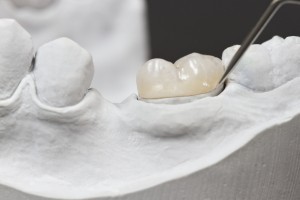 If you have a tooth that has been structurally damaged by decay or trauma, your Auburn dentist may suggest the use of a crown.
If you have a tooth that has been structurally damaged by decay or trauma, your Auburn dentist may suggest the use of a crown.
A dental crown is a cover or cap that fits over the main structure of your tooth. Its’ purpose is to restore the original shape, size and strength of your tooth. Some crowns are designed to match your natural tooth’s appearance, and in most cases other people won’t notice if a tooth has a crown on it.
Why Do I Need a Crown?
Your dentist may suggest a dental crown in order to:
- Replace a large filling if the tooth has lost too much of its structure
- Protect a weak tooth from breaking or fracturing
- Restore a tooth that is already fractured or suffers from extreme wear
- Provide support for a dental bridge
- Cover a severely discolored or malformed tooth
- Cover a dental implant
- Cover a tooth that has received root canal treatment
What Are Crowns Made of?
Crowns are available in a variety of types and materials, each with their specific advantages and disadvantages. Crown types include the following:
Metal:
Metal crowns may include alloys made of gold, palladium, or other “base-metals” such as nickel or chromium.
- Pros: Withstand biting and chewing forces well, relative long life, rarely chip or break. Additionally, less tooth structure must be removed with metal crowns, and opposite tooth wear is minimum.
- Cons: The metallic color makes these crowns more noticeable than other types. Many patients choose metal crowns for molars that are not in plain view.
Porcelain fused to metal:
These crowns are made of a combination of two materials.
- Pros: Can be color matched to adjacent teeth, relatively strong.
- Cons: Cause more wear to opposing teeth, metal part of crown may be visible, porcelain portion is susceptible to breakage or chipping.
All-resin:
These crowns are constructed from composite material similar to that used for tooth fillings.
- Pros: Less expensive, can be color matched to adjacent teeth.
- Cons: Wear down over time and more prone to fractures than other types of crowns.
Ceramic or Porcelain:
These materials are often used to restore front teeth.
- Pros: Provide the best color match to adjacent teeth, suitable alternative to patients with metal allergies.
- Cons: Weaker than other materials, wear down opposing teeth more quickly.
The process of preparing and placing a crown will vary depending on the type and material used. If the crown is to be prepared in a lab, you will need two visits to the dentist. The lab technicians may need anywhere between one to three weeks to create your finished crown.
How Long Will It Last?
Avoid chewing hard foods or ice and you will extend the life of your crown as long as possible.
Although some crowns loosen or even fall out over time, many crowns last a lifetime if properly maintained. A good oral routine, including brushing and flossing twice a day, will help you achieve this goal.
